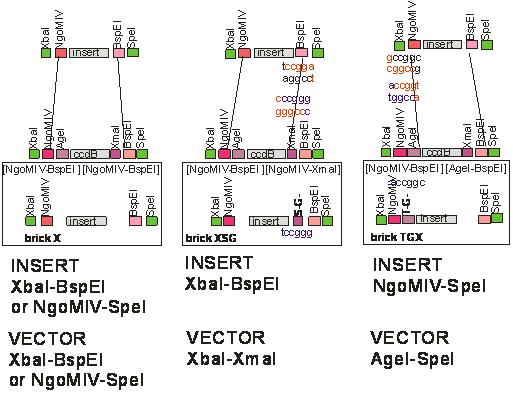Team:Slovenia/Biobrick
From 2009.igem.org
|
|
Improved BioBrick StandardFor a multitude reasons we would like to work with the upgrade of 2007 Freiburg iGEM proposed standard (Assembly standard 25). The upgrade includes altered multiple-cloning site which enables friendly scar after part ligation and simple extension of linker between parts. Advantages:
restriction enzymes enables part transfer between different formats and other potentially interesting transfer reactions Disadvantages:
A: BioBrick-NIC-II originates from standard Biobrick vectorThe difference is in multiple cloning sites.
prefix: 5' gaattc(EcoRI) gcggccgc(NotI) promoter (invariant region) tctaga(XbaI) gccggc(NgoMIV) accggt(AgeI) suffix: 5' cccggg(XmaI) tccgga(BspEI) terminator (invariant region) gcggccg(NotI) ctgcag(PstI)
B: Multiple-cloning siteThree types of multiple cloning sites were constructed. First, between NotI site and XbaI sites of multiple cloning site of standard Biobrick vector a T7 promoter and ATG (star codon) with or without His-tag were inserted. Between SpeI and NotI sites a TAA (stop codon) and T7 terminator with or without His-tag were inserted. Between XbaI and SpeI site NgoMIV, AgeI, XmaI and BspEI sites were inserted. To simplify selection of positive clones containing ligated parts a CcdB domain was inserted between AgeI and XmaI sites.
gaattc(EcoRI) gcggccgc(NotI) T7-promoter-RBS-ATG Tyr-His-tag tctaga(XbaI) gccggc(NgoMIV) accggt(AgeI) ccdB-domain cccggg(XmaI) tccgga(BspEI) actagt(SpeI) STOP-T7-terminator gcggccg(NotI) ctgcag(PstI)
gaattc(EcoRI) gcggccgc(NotI) T7-promoter-RBS-ATG tctaga(XbaI) gccggc(NgoMIV) accggt(AgeI) ccdB-domain cccggg(XmaI) tccgga(BspEI) actagt(SpeI) STOP-T7-terminator gcggccg(NotI) ctgcag(PstI)
gaattc(EcoRI) gcggccgc(NotI) T7-promoter-RBS-ATG tctaga(XbaI) gccggc(NgoMIV) accggt(AgeI) ccdB-domain cccggg(XmaI) tccgga(BspEI) actagt(SpeI) Tyr-His-tag STOP-T7-terminator gcggccg(NotI) ctgcag(PstI) T7-promoter-RBS-ATG: taatacgactcactataggggaattgtgagcggataacaattcccctGtagaaataattttgtttaactttaaga aggaggtaaata ATG Tyr-His-tag: TAT catcaccatcaccatcac STOP-T7-terminator: TAA ctagcataaccccttggggcctctaaacgggGctagaggggttttttg
C: RestrictionsAllowed sequences within BioBrick-NIC-II parts include any DNA sequence which does not contain the following subsequences: GAATTC recognized by EcoRI restriction enzyme; CTGCAG recognized by PstI restriction enzyme; GCGGCCGC recognized by NotI restriction enzyme; ACTAGT recognized by SpeI restriction enzyme; TCTAGA recognized by XbaI restriction enzyme; GCCGGC recognized by NgoMIV restriction enzyme; TCCGGA recognized by BspEI restriction enzyme; CCCGGG recognized by XmaI restriction enzyme; ACCGGT recognized by AgeI restriction enzyme.
D: Cloning
1. Into XbaI and SpeI restriction site of multiple cloning sites. 2. Into NgoMIV and BspEI restriction site of multiple cloning sites. 3. Into NgoMIV and XmaI restriction site of multiple cloning sites. With this ligation two additional amino acids, Ser and Gly, are added on C terminal site of part. 4. Into AgeI and BspEI restriction site of multiple cloning sites. With this ligation two additional amino acids, Thr and Gly, are added on N terminal site of part.
E: Assembly Scars
F: CompatibilityEach part suited for cloning into standard Biobrick vector could be cloned also into vector BioBrick-NIC-II and vice versa. The part suitable for standard Biobrick vector could be cloned into BioBrick-NIC-II vector into XbaI, SpeI restriction sites in multiple cloning site.
G: Plasmid contextBioBrick-NIC-II vector is composed from similar elements (antibiotic resistance, origin of replication, ccdB domain) as standard Biobrick vectors with the exception of multiple cloning site.
H: SequencingSequencing primers are identical as sequencing primers for standard Biobrick vectors and are: VF2: TGCCACCTGACGTCTAAGAA; VR: ATTACCGCCTTTGAGTGAGC.
I: StrainsThe BioBrick-NIC-II vector and parts cloned into BioBrick-NIC-II vector could be cloned into the bacterial K-12 cloning strain (endA-). We recommend strains such as Top10, DH10B, and DH5a. |
 "
"



